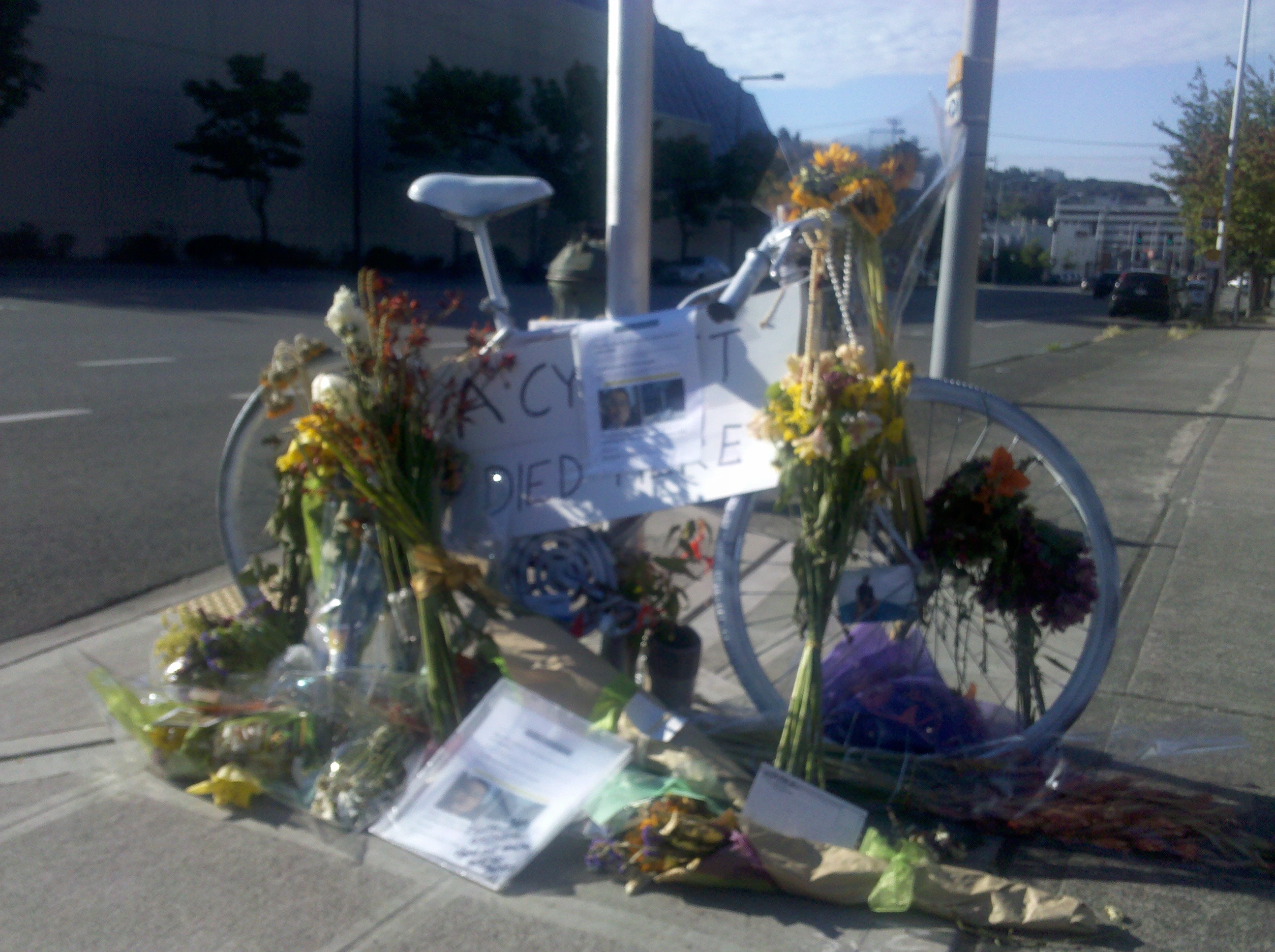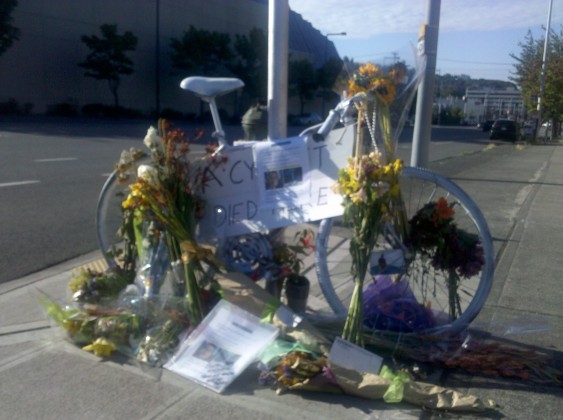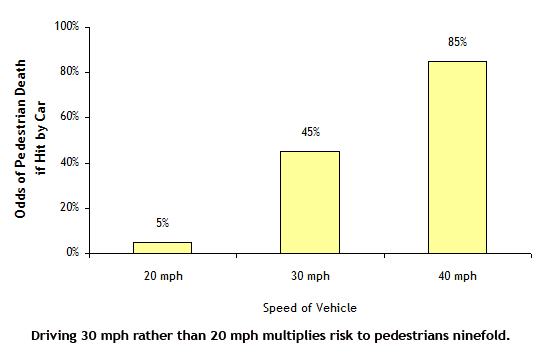Update: The Washington Legislature passed the Neighborhood Safe Streets bill in April 2013, finally cutting red tape that cities and towns previously faced when they chose to set speed limits at 20 miles an hour on residential and business non-arterial streets. This common sense win for pedestrians, kids, and the elderly had overwhelming support in the House (86-10) and Senate (45-2), yet took three years to clear the roadblocks embedded in our political system.
A shorter version of this item ran on the Seattle Times’ op-ed page on August 2, 2011. This version includes links, a chart, and additional analysis.
On Thursday afternoon, I got a pit in my stomach when I found strings of yellow police tape blocking the bike commute on Seattle’s Dexter Avenue. I learned over the hours that followed, with all of Seattle, that an SUV had struck and fatally injured Mike Wang, a PATH photographer of my age, in his forties. Mr. Wang had been riding in the Dexter bike lane at Thomas Street when the SUV sped across traffic, slammed into him, and fled the scene.
Such calamities are far too common. In 2009, traffic collisions killed 1,095 people—including 106 pedestrians and cyclists—in the Northwest states of Idaho, Oregon, and Washington. Car crashes are the number one cause of death among American children and young adults, and the group of pedestrians most in jeopardy is seniors. The pedestrian traffic death rate is more than twice as high among seniors as among others in Oregon and Washington. It’s three times as high in Idaho. (Sources for this paragraph and the next are at the bottom of this post.)
In almost all of these deaths, traffic speed is a critical variable. Some 91 percent of 2009 Northwest traffic deaths occurred on streets with speed limits of 30 mph, like Dexter, or higher. That’s a big number. Let’s make it more real: A new mapping tool allows you to pinpoint the exact locations, with street-view photos, of every scene where a motor vehicle killed an American pedestrian in the last decade. The map is harrowing. In a few short minutes of clicking and zooming, for example, I saw the death scenes of an 89-year-old man, a 73-year-old man, a 16-year-old boy, and a 1-year-old boy in Spokane; a 75-year-old woman and a 37-year-old man in Federal Way, Washington; and a 13-year-old girl in Sumner, Washington. Every one of these deaths was on a local street, the speed limit of which is dictated by state law at either 25 or 30 mph.
For all that cities try to improve street safety, with cross walks, signals, and traffic circles, state law binds them in red tape if they want to lower these speed limits. Localities cannot lower speeds on their streets without first doing extensive and expensive speed and engineering studies. That’s right: costly studies are required just to make commonsense safety improvements.
The rest of the Northwest trusts its localities more than we do. In June, Oregon passed HB 3150, giving more discretion to localities to reduce speed limits on low-traffic residential roadways. From the current standard of 25 mph, they will be allowed to drop the limit to 20 mph. The City of Portland hopes to use this authority to strengthen its network of Bicycle Boulevards, which are similar to what Seattle calls Greenways.
Washington’s legislature took up a similar bill this year, HR 1217, the “local speed limit bill.” It garnered bipartisan support and passed the house unanimously, but the senate failed to move it out of committee. HR 1217 would have let cities use their judgment about establishing 20 mph zones.
Washington’s bill was a start. A fuller measure would have taken Idaho’s approach, letting cities adjust speed limits however they see fit. Or British Columbia’s approach, which welcomes cities to push maximum speeds as low as 20 kilometers per hour (12 mph). Until Washington cities have the authority of their counterparts in BC and Idaho, fixing streets like Dexter will remain needlessly slow and burdensome.
Seattle, like communities across the state, is striving to make things safer. We’re painting bike lanes, installing cross walks, and even organizing walking school buses. Yet state law handicaps us by making it costly and cumbersome to calm traffic.
The national nonprofit Transportation for America has found that only 1 percent of pedestrian deaths during the 2000s occurred on streets with posted speeds of 20 mph or lower. Granted, these figures may primarily reflect the fact that most driving happens on roads with higher speed limits. Still, the laws of physics themselves dictate speed’s danger. Newton showed that doubling speed requires quadrupling kinetic energy. It also quadruples stopping distance, and it radically increases the crushing force of impact. As shown in the figure above, a 1994 study from the United Kingdom estimated that if a vehicle is traveling at 20 mph when it hits a pedestrian, the chance of death for the pedestrian is 5 percent. At the Dexter Avenue speed limit of 30 mph, the chance of death multiplies nine-fold, to 45 percent. At 40 mph, the chance of death rises to 85 percent. Roads with fast motorized traffic also intimidate walkers and cyclists, pushing more people into cars, while calming traffic induces more people to walk or bike. Slower auto speeds also save lives.
A 25-mph speed limit on Dexter might or might not have saved Mike Wang’s life. The hit-and-run driver of the brown SUV that killed him could well have been oblivious to posted speeds, and Dexter is so wide that it almost invites speeding. We cannot know. What we can know, and what the spontaneous memorial that has emerged at Dexter and Thomas reminds us, is that it’s time for Olympia to get out of the way and let us make our streets safer. In Seattle, no one should die for riding his bike.
Notes: I queried the database at the National Highway Traffic Safety Administration to find the figures on fatalities in the Northwest and deaths on streets with different speed limits. The figures cover Idaho, Oregon, and Washington for 2009. I excluded about 8 percent of fatalities, for which no speed limit data were available or (in rare cases) where no legal limit existed.












Steve Hoyt-McBeth
Great piece, Alan. This is a trite comment, but in Portland we’ve recast bicycle boulevards as neighborhood greenways: http://www.portlandonline.com/transportation/index.cfm?&c=50518